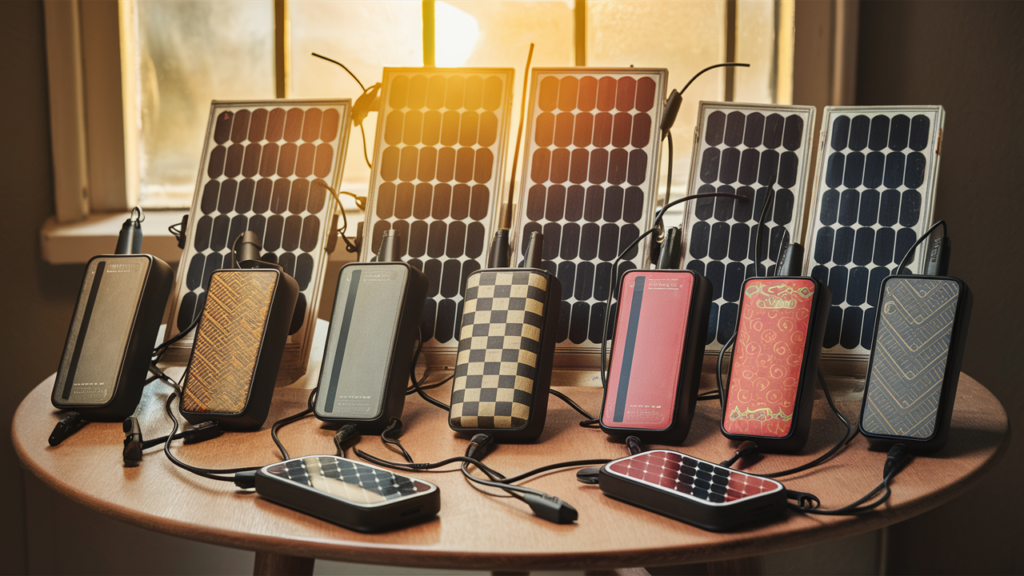To make a solar charger for your mobile, gather a solar panel, a charge controller, and a battery. Connect these components to a USB port for charging.
Creating a solar charger offers a sustainable solution for mobile device users. As reliance on smartphones increases, so does the need for portable charging options. A solar charger harnesses sunlight, allowing you to recharge your device anywhere outdoors. This eco-friendly gadget is perfect for camping trips, hiking, or any outdoor activity.
Building one at home not only saves money but also enhances your DIY skills. Understanding the components and their connections is crucial for successful assembly. With a few materials and some basic knowledge, you can create a reliable solar charger to keep your devices powered up.
Introduction To Diy Solar Chargers
DIY solar chargers are gaining popularity. These devices allow you to harness the sun’s energy. You can charge your mobile devices anywhere. This post explores the benefits and steps to create your own solar charger.
The Rise Of Renewable Energy Diy Projects
More people are embracing renewable energy. DIY projects are becoming trendy. Here are some reasons:
- Cost savings on energy bills
- Reduced carbon footprint
- Increased energy independence
- Fun and educational experience
DIY solar chargers are perfect for beginners. They offer hands-on experience with renewable energy. As you build, you learn about solar technology.
Benefits Of Building Your Own Solar Charger
Building a solar charger has many benefits:
- Affordability: Saves money compared to buying a ready-made charger.
- Customization: Tailor it to your specific needs.
- Portability: Design a lightweight model for travel.
- Learning experience: Gain practical skills in electronics.
- Sustainability: Promote clean energy use.
Creating your own solar charger is rewarding. It empowers you to embrace a sustainable lifestyle.
Essential Components For Solar Chargers
Creating a solar charger for your mobile device requires several key components. Each part plays a vital role in converting sunlight into usable energy. Understanding these components will help you build an efficient solar charger.
Solar Panels Explained
Solar panels are the heart of your solar charger. They convert sunlight into electricity. Here are key points to consider:
- Types of panels: Monocrystalline, polycrystalline, and thin-film.
- Efficiency: Higher efficiency means more power output.
- Wattage: Choose panels based on your charging needs.
Most mobile chargers use panels rated between 5W to 20W.
Battery Storage Options
Batteries store energy for later use. Choose the right type for your charger. Here are common battery options:
| Battery Type | Pros | Cons |
|---|---|---|
| Lithium-ion | Lightweight, high capacity | Higher cost |
| Lead-acid | Inexpensive, durable | Heavier, less efficient |
| Nickel-metal hydride | Good performance | Limited availability |
Choose a battery that fits your needs and budget.
Charge Controllers For Energy Regulation
Charge controllers manage the energy flow from solar panels to batteries. They prevent overcharging and ensure safety. Here are key features:
- PWM (Pulse Width Modulation): Cost-effective and reliable.
- MPPT (Maximum Power Point Tracking): Maximizes energy efficiency.
Using a charge controller increases battery life and performance.
Selecting The Right Solar Panel
Choosing the right solar panel is crucial for building an efficient solar charger. The panel’s type and specifications directly affect your mobile charging experience. Let’s explore the options available.
Types Of Solar Panels Available
Solar panels come in various types. Here are the most common:
- Monocrystalline Panels
- High efficiency
- Space-efficient
- Long lifespan
- Polycrystalline Panels
- Less expensive
- Lower efficiency than monocrystalline
- Good for larger spaces
- Thin-Film Panels
- Flexible and lightweight
- Lower efficiency
- Ideal for portable chargers
Understanding Solar Panel Specifications
Solar panel specifications help determine performance. Focus on these key factors:
| Specification | Description |
|---|---|
| Wattage | Indicates the power output. |
| Efficiency | Percentage of sunlight converted to electricity. |
| Voltage | Required voltage for charging devices. |
| Size | Physical dimensions of the panel. |
Select a panel with high wattage and efficiency. Match the voltage to your mobile device. These factors ensure effective charging.
Battery Choices For Your Solar Charger
Choosing the right battery is crucial for your solar charger. Batteries store energy from the sun. They power your mobile devices when needed. Two main types are commonly used: lead-acid and lithium-ion.
Lead-acid Vs. Lithium-ion
Both battery types have pros and cons. Here’s a quick comparison:
| Feature | Lead-acid | Lithium-ion |
|---|---|---|
| Cost | Less expensive | More expensive |
| Weight | Heavier | Lighter |
| Life span | 3-5 years | 10+ years |
| Efficiency | Less efficient | More efficient |
| Maintenance | Requires maintenance | No maintenance |
Lead-acid batteries are cheaper but heavier. They need maintenance and have a shorter lifespan. On the other hand, lithium-ion batteries are lightweight and efficient. They last longer and require no maintenance.
Calculating Battery Capacity Requirements
Understanding battery capacity is key for your solar charger. Capacity is measured in amp-hours (Ah). Here’s how to calculate it:
- Determine your device’s power consumption. Check the device’s specifications.
- Decide how long you want to charge your device.
- Use this formula: Capacity (Ah) = Power (W) x Time (h) / Voltage (V).
For example, if your phone needs 5W and you want to charge it for 3 hours:
- Capacity = 5W x 3h / 5V = 3Ah
You need a battery with at least 3Ah capacity. Always choose a battery with a higher capacity for better performance.
The Role Of Charge Controllers
Charge controllers play a crucial role in solar chargers. They manage the flow of electricity from the solar panels to the battery. Without them, batteries may get damaged. Charge controllers prevent overcharging and enhance battery life. They ensure safe and efficient energy storage for your devices.
Preventing Overcharging
Overcharging can harm batteries. It may lead to overheating and reduced lifespan. Charge controllers monitor battery voltage. They stop charging when the battery is full. This feature protects the battery from damage.
- Prevents overheating
- Extends battery lifespan
- Maintains efficiency
Mppt Vs. Pwm Controllers
Two common types of charge controllers are MPPT and PWM. Each has different functions and benefits.
| Feature | MPPT (Maximum Power Point Tracking) | PWM (Pulse Width Modulation) |
|---|---|---|
| Efficiency | Higher efficiency (up to 95%) | Lower efficiency (around 75-80%) |
| Cost | More expensive | Less expensive |
| Best for | Large solar systems | Small solar systems |
Choose the right controller for your needs. MPPT controllers are best for larger systems. PWM controllers work well for smaller setups.
Assembling Your Solar Charger
Building your own solar charger is simple and fun. Follow these steps to create a reliable power source for your mobile device. Gather your materials and get ready to assemble!
Step-by-step Assembly Process
- Gather Materials: You need a solar panel, a charge controller, a battery, and a USB port.
- Connect the Solar Panel: Attach the solar panel to the charge controller using wires.
- Install the Battery: Connect the battery to the charge controller. Make sure to follow the correct polarity.
- USB Port Connection: Connect the USB port to the charge controller. This will allow you to charge your mobile device.
- Secure Everything: Use a sturdy case or enclosure to protect your components.
- Test the Charger: Place the solar charger in sunlight. Check if your mobile device charges.
Safety Precautions During Assembly
- Work in a Dry Area: Avoid water around electrical components.
- Wear Safety Gear: Use gloves and safety glasses to protect yourself.
- Check Connections: Ensure all connections are tight to prevent shorts.
- Use Proper Tools: Use insulated tools to avoid electric shocks.
- Follow Instructions: Always refer to the manual for each component.
Wiring And Connections
Wiring and connections are key parts of building a solar charger. Proper wiring ensures your solar charger works efficiently. Understanding these basics will help you avoid common mistakes.
Basic Electrical Wiring For Solar
Start with understanding the basic electrical wiring. Here are the essential components:
- Solar panels: Collect sunlight and convert it to electricity.
- Charge controller: Regulates the voltage and current.
- Battery: Stores electricity for later use.
- Inverter: Converts DC to AC if needed.
Follow these steps for basic wiring:
- Connect the solar panel to the charge controller.
- Attach the charge controller to the battery.
- Connect the battery to the inverter, if used.
Use the following table for wiring guidelines:
| Component | Connection |
|---|---|
| Solar Panel | Positive to Charge Controller Positive |
| Charge Controller | Positive to Battery Positive |
| Battery | Positive to Inverter Positive (if needed) |
Connecting Multiple Panels
To boost power, connect multiple solar panels. You can connect them in series or parallel.
- Series Connection: Increases voltage. Connect positive to negative.
- Parallel Connection: Increases current. Connect positive to positive and negative to negative.
Follow these steps for connecting multiple panels:
- Determine whether to connect in series or parallel.
- Make sure all panels match in voltage and current.
- Securely connect wires to avoid loose connections.
Check your connections with a multimeter. This ensures everything is working correctly.

Testing And Troubleshooting
After building your solar charger, testing is crucial. This ensures your device works correctly. Troubleshooting helps identify and fix any issues quickly.
Initial Testing Procedures
Start by checking all connections. Ensure the solar panel connects well to the battery and output. Follow these steps:
- Place the solar panel in direct sunlight.
- Use a multimeter to measure the voltage output.
- Check the battery voltage after a few hours.
- Connect your mobile device to the charger.
Monitor the charging status on your mobile. A good sign is the charging icon appearing.
Common Issues And How To Fix Them
Sometimes, problems may arise. Here are common issues and solutions:
| Issue | Solution |
|---|---|
| No output from the solar panel | Check for dirt or debris on the panel. |
| Battery not charging | Inspect battery connections for loose wires. |
| Slow charging speed | Ensure the solar panel receives maximum sunlight. |
| Overheating | Use a heat-resistant casing for the battery. |
Follow these solutions to resolve issues quickly. Testing and troubleshooting help ensure a successful solar charger.
Mounting And Deploying Your Solar Charger
Properly mounting and deploying your solar charger is essential. It ensures maximum efficiency and power generation. Follow these steps for the best results.
Choosing The Right Location
Selecting the right spot is crucial for your solar charger. Consider these factors:
- Sunlight Exposure: Choose a location with direct sunlight.
- Shade: Avoid areas with trees or buildings casting shadows.
- Accessibility: Ensure easy access for adjustments and maintenance.
- Weather Protection: Protect from extreme weather conditions.
Use a solar pathfinder tool to find the best spots. This tool shows sun patterns throughout the day.
Mounting Techniques For Optimum Exposure
Proper mounting techniques enhance sunlight exposure. Use these methods:
- Adjustable Mounts: Use adjustable mounts for angle changes.
- Fixed Mounts: Secure fixed mounts facing south for maximum exposure.
- Pole Mounts: Consider pole mounts for elevated positioning.
- Wall Mounts: Use wall mounts for small chargers in urban areas.
Ensure all mounts are sturdy and weather-resistant. Regularly check for dust or debris on the solar panel.
| Mount Type | Best For | Pros | Cons |
|---|---|---|---|
| Adjustable | Variable sunlight | Maximizes sun exposure | Requires regular adjustments |
| Fixed | Stable locations | Simpler installation | Less flexibility |
| Pole | Open areas | Higher exposure | More complex setup |
| Wall | Urban settings | Space-saving | Limited angle adjustment |
Choose the best mounting technique for your needs. Proper mounting leads to better solar energy harnessing.
Maintenance And Care
Taking care of your DIY solar charger ensures it works well. Regular maintenance keeps it efficient and prolongs its lifespan. Follow these tips for proper care.
Routine Maintenance Checklist
- Clean the solar panels every month. Use a soft cloth.
- Check for debris like leaves or dust. Remove any blockages.
- Inspect connections for corrosion. Tighten loose wires.
- Test the charger every few weeks. Ensure it charges devices.
- Store properly during bad weather. Keep it dry and safe.
Longevity Tips For Your Diy Solar Charger
- Use quality materials. Invest in durable solar panels.
- Protect from extreme temperatures. Avoid direct sunlight in storage.
- Keep it out of reach of children and pets.
- Avoid overcharging. Disconnect devices once fully charged.
- Regularly update your knowledge on solar tech. Stay informed on best practices.
Following these maintenance tips helps your DIY solar charger last longer. Enjoy hassle-free charging anytime, anywhere.
Upgrading Your Solar Charger
Upgrading your solar charger can enhance its efficiency and usability. Small improvements can lead to big benefits. This section covers expansion possibilities and technology advancements.
Expansion Possibilities
Expanding your solar charger can make it more powerful. Consider these options:
- Adding extra solar panels: More panels capture more sunlight.
- Integrating a larger battery: A bigger battery stores more energy.
- Using a charge controller: This prevents overcharging and improves safety.
Think about a portable design. You can use it anywhere. This makes it perfect for camping or travel.
Check these expansion ideas:
| Expansion Option | Benefits |
|---|---|
| Extra Solar Panels | Increased energy collection |
| Larger Battery | Longer device usage |
| Charge Controller | Enhanced safety |
Incorporating Technology Advancements
Technology can significantly boost your solar charger. Use these advancements:
- Solar Flexibility: Flexible solar panels are lightweight and portable.
- Smart Charge Technology: Automatically adjusts charging speed.
- Wireless Charging: Charge devices without cords.
These upgrades can improve your solar charger’s performance. They also make it easier to use.
Stay informed about new technologies. This knowledge helps you make better choices.
Conclusion: Embracing Solar Power
Creating a solar charger for your mobile device is rewarding. It reduces reliance on traditional electricity sources. Embracing solar power leads to a sustainable future.
Environmental Impact Of Going Solar
Switching to solar power has several benefits:
- Reduces carbon footprint: Solar energy decreases greenhouse gas emissions.
- Conserves resources: Solar power uses sunlight, a renewable resource.
- Minimizes pollution: Solar installations produce little to no pollution.
| Environmental Benefit | Description |
|---|---|
| Lower Emissions | Less reliance on fossil fuels reduces harmful emissions. |
| Resource Efficiency | Solar panels use abundant sunlight, conserving natural resources. |
| Cleaner Air | Solar energy contributes to cleaner air quality. |
Final Thoughts On Diy Solar Chargers
Building a DIY solar charger is simple and fun. It promotes eco-friendly practices. Each step helps you learn about renewable energy.
- Choose quality solar panels.
- Use durable materials for longevity.
- Test the charger before full use.
DIY solar chargers empower individuals. They provide independence from conventional power sources. Start embracing solar power today!
Frequently Asked Questions
How Does A Solar Charger Work For Mobile Devices?
A solar charger converts sunlight into electricity. It uses solar panels to capture sunlight and convert it into usable power. This energy is then stored in a battery or sent directly to your mobile device. This eco-friendly solution helps keep your devices charged while on the go.
What Materials Do I Need For A Solar Charger?
To make a solar charger, you’ll need solar panels, a charge controller, a battery, and a USB output. You may also require wires and a sturdy enclosure to protect the components. These materials ensure efficient energy conversion and safe charging for your mobile devices.
Can I Use Any Solar Panel For Charging?
Not all solar panels are suitable for charging mobile devices. It’s best to use panels designed for portable chargers, typically rated between 5 to 20 watts. Ensure the panel’s output matches your device’s charging requirements for optimal performance and safety.
How Long Does It Take To Charge A Mobile With Solar?
Charging time varies based on sunlight intensity and panel efficiency. Typically, it can take anywhere from 2 to 8 hours to fully charge a mobile device. Ensure the solar panel is positioned directly toward the sun for the fastest charging experience.
Conclusion
Creating a solar charger for your mobile device is both rewarding and practical. This DIY project not only saves energy but also promotes sustainability. With the right materials and steps, you can ensure your devices stay powered while enjoying the outdoors.
Embrace renewable energy and enjoy the convenience of solar charging today!








